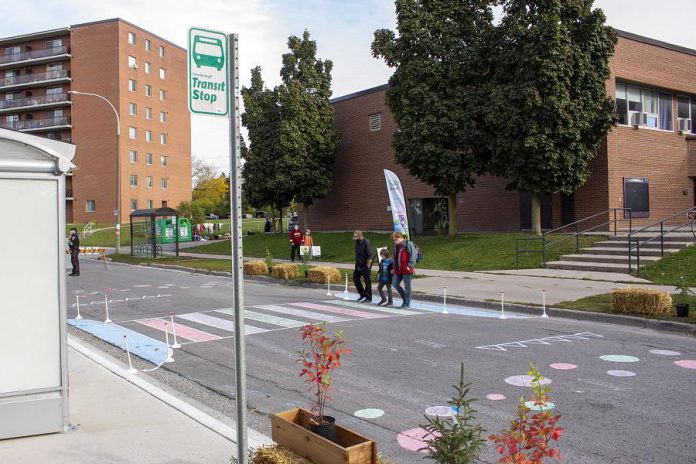
International Women’s Day is Monday, March 8th. The theme this year is “Choose to Challenge”. Join me as I choose to challenge gender bias in how cities have conventionally been designed.
Many cities have been designed by urban planners who identify as men for residents who identify as men.
This privileges the structures and patterns of a patriarchal world, like the weekday routine of travelling between home and work for a 9-to-5 job. This patriarchal way of designing cities values business places and the economic status associated with the cars and roads that get people to and from those places of business.
By comparison, little value is placed on the domestic spaces and unpaid labour of childcare and housekeeping that necessarily support that patriarchal world of business.
“The design of public spaces is not neutral,” says Jay Pitter, award-winning placemaker and author in an interview with She Does The City. “Feminist scholars have found that the home, a domestic space associated with nurturing and child-rearing, was conceived as a women’s space. And the city, associated with economic opportunity, mobility, and exploration, was conceived as a space for men.”
“Challenges women face — such as navigating public transit with strollers, accessing family-friendly public restrooms, and overall safety in the public realm — are all linked to fundamental, gender-based urban design biases,” Pitter adds.

Urban planning has traditionally privileged a set eight-hour workday for men over the less regular, often part-time, and unpaid labour that has been associated with women.
For example, in Canada, women are twice as likely as men to work part-time. Women make up a higher percentage of those who commute to work on public transit than men. Statistics from the 2016 Census show 58.5 per cent of transit users in Toronto were women and 41.5 per cent were men. Women spend an average of 5.4 hours per day on unpaid work activities related to housekeeping and caregiving, whereas men spend an average of 2.9 hours per day.
To keep the household running smoothly, it is still women who do more short-trip, dart-and-dash activities to various destinations. Active transportation like biking or walking is often a more cost-effective and time-efficient method for these shorter trips than a privately owned car or public transit. Urban spaces need to be planned with different priorities to accommodate these trips.
The safety of women and children — as well as other segments of the population — would be improved significantly if streets were designed with wide sidewalks and boulevards, protected bicycle lanes, places to sit, and intersections with short crossing distances. Slower vehicular traffic also improves safety for women and the children who often accompany them on these trips.
Access to public washrooms would also make an enormous difference in women’s ability to enjoyably participate in their cities. Women have to use washrooms more often than men, and women are more likely to be out with children who need these facilities on a frequent and often urgent basis.
When we choose to challenge gender bias, everyone benefits. For example, in the 1990s, Toronto changed bus and streetcar services to address women’s safety needs. Women were allowed to request a stop between regular stops. This service now extends to all passengers.
VIDEO: “How to Build a City for Women”
Better cycling infrastructure encourages more people to feel safe when cycling and can also increase retail spending in downtown cores. Increases in active transportation can improve air quality and personal health. Better active transportation infrastructure also makes business and services more accessible for folks who cannot afford, or choose not to own, a car.
Everyone — not just women — benefits from compact, mixed-use, walkable neighbourhoods. The Canadian population is aging and women, on average, live longer than men. Compact, walkable communities can create a better quality of life for elderly women living alone and for everyone else too.
More walkable communities provide better quality of life to Canada’s aging population, and these communities are also more attractive places to live in general. A 2014 study revealed that 81 per cent of homebuyers would choose to live in less car-dependent neighbourhoods over having big lawns and extra bedrooms, if cost were not a factor.
All levels of government need to coordinate to create affordable housing plans and compact, mixed-use, walkable neighbourhoods. If you want to learn more from exemplars around the world, look to the design of the Aspern community in Vienna: one half of the development area is devoted to public space, building height allows for enhanced safety and better “eyes on the street,” and the streets are named after women.
You can also look for more inclusive urban design solutions closer to home.
Over the past year we all experienced how the COVID-19 emergency made it essential to our health, safety, and local economy to adopt many urban design measures that are prioritized in approaches that consider the experiences of women: dedicated cycling lanes, larger pedestrian spaces with more outdoor seating/patios, and reduced vehicle speed limits.

Over the past four years, as part of GreenUP’s NeighbourPLAN program, I have had the privilege of meeting with over 1,000 people of all genders and walks of life: drivers, cyclists, walkers and rollers, students, and retired folks, those with comfortable incomes and those surviving on low and fixed incomes.
All these people experience our city in their own unique ways, and yet they share common dreams for their neighbourhoods. They want safe and accessible streets, as well as more beauty and greenery. They have some great ideas on how to adapt current public space to achieve these goals.
Through collaboration with built environment professionals, these ideas have been distilled into actionable vision documents that you can view at greenup.on.ca/neighbourplan/.
VIDEO: “Designing cities for women” – Lucy Turnbull
Great things can happen when we choose to challenge urban designs that prioritize men over women, cars over people, 9-to-5 jobs over part-time and irregular shift work. The people who call our cities home are more diverse than these either-this-or-that divisions.
Championing these changes and this diversity should not be a fight. When we design cities to work for the most vulnerable people, we get cities that work better for everyone. Choose to challenge how your city works for you.


























